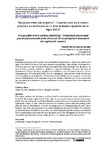Mostrar o rexistro simple do ítem
“Se puede vivir sin respirar”. Contexto teórico y marco práctico de los buzos en la Real Armada española en el siglo XVIII
| dc.contributor.author | García Hurtado, Manuel-Reyes | |
| dc.date.accessioned | 2024-07-18T09:12:51Z | |
| dc.date.available | 2024-07-18T09:12:51Z | |
| dc.date.issued | 2021-05 | |
| dc.identifier.citation | García Hurtado, M.-R. . (2021). “Se puede vivir sin respirar”. Contexto teórico y marco práctico de los buzos en la Real Armada española en el siglo XVIII. Revista Paginas, 13(32). https://doi.org/10.35305/rp.v13i32.501 | es_ES |
| dc.identifier.uri | http://hdl.handle.net/2183/38132 | |
| dc.description.abstract | [Resumen] Analizamos la producción escrita y los principales instrumentos y máquinas ideados a lo largo de la Edad Moderna en Europa destinados a posibilitar el aprendizaje de la natación y del buceo, así como las técnicas médicas en el siglo XVIII para reanimar a los ahogados. En este contexto cultural, material y científico, a raíz del naufragio del navío San Juan de Alcántara en 1786 se plantea en España la necesidad de crear escuelas de buceo en los tres Departamentos de la Armada (Cádiz, Ferrol y Cartagena). Esta iniciativa será la primera a nivel mundial, pero su desarrollo y efectos fueron muy limitados, lo que supuso un elemento más de debilitamiento de la Armada a finales del Antiguo Régimen, ya que los buzos eran tan esenciales en los arsenales y en las embarcaciones como siempre fueron absolutamente insuficientes. | es_ES |
| dc.description.abstract | [Abstract] This paper analyses the literature produced and the principal instruments and machines devised in Europe throughout the Modern Age, whose purpose was to teach people to swim and to dive, as well as the medical techniques employed to revive drowned victims in the eighteenth century. In this cultural, material and scientific context, after the sinking of the ship San Juan de Alcántara in 1786 the pressing issue of creating diving schools in three departments of the Armada (Cadiz, Ferrol and Cartegena) was raised in Spain. This initiative would be the first of its kind in the world, but its development and effects were very limited, thus contributing to undermine the Armada at the end of the Old Regime, for divers were as essential in arsenals and on board ships as they were always insufficient in number. | es_ES |
| dc.description.sponsorship | Trabajo realizado en el marco del Proyecto I+D de Generación de Conocimiento “Dinámicas y conflictividad en el litoral del Noroeste peninsular en la Edad Moderna” (ref. PGC2018-093841-B-C33), del Ministerio de Ciencia, Innovación y Universidades de España, con una cofinanciación del 80% FEDER. | es_ES |
| dc.language.iso | spa | es_ES |
| dc.publisher | Universidad Nacional de Rosario | es_ES |
| dc.relation | info:eu-repo/grantAgreement/AEI/Plan Estatal de Investigación Científica y Técnica y de Innovación 2017-2020/ PGC2018-093841-B-C33/ES/DINÁMICAS Y CONFLICTIVIDAD EN EL LITORAL DEL NOROESTE PENINSULAR EN LA EDAD MODERNA/ | es_ES |
| dc.relation.uri | https://doi.org/10.35305/rp.v13i32.501 | es_ES |
| dc.rights | Atribución-NoComercial-CompartirIgual 3.0 España | es_ES |
| dc.rights.uri | http://creativecommons.org/licenses/by-nc-sa/3.0/es/ | * |
| dc.subject | Nadar | es_ES |
| dc.subject | Bucear | es_ES |
| dc.subject | Campana de buceo | es_ES |
| dc.subject | Ahogado | es_ES |
| dc.subject | Armada | es_ES |
| dc.subject | Swimming | es_ES |
| dc.subject | Diving | es_ES |
| dc.subject | Diving bell | es_ES |
| dc.subject | Drowned victim | es_ES |
| dc.title | “Se puede vivir sin respirar”. Contexto teórico y marco práctico de los buzos en la Real Armada española en el siglo XVIII | es_ES |
| dc.title.alternative | ‘It is possible to live without breathing.’ Theoretical context and practical framework of the divers of the royal Spanish Armada in the eighteenth century | es_ES |
| dc.type | info:eu-repo/semantics/article | es_ES |
| dc.rights.access | info:eu-repo/semantics/openAccess | es_ES |
| UDC.journalTitle | Páginas | es_ES |
| UDC.volume | 13 | es_ES |
| UDC.issue | 32 | es_ES |
Ficheiros no ítem
Este ítem aparece na(s) seguinte(s) colección(s)
-
II - Artigos [569]






